China’s Health Services Struggle After Abrupt Unwinding of Stringent COVID Curbs
Over the past week, long lines have formed outside fever clinics, calls have inundated China’s emergency hotline, and businesses are preparing for new interruptions as a growing number of employees become sick.These chaotic scenes unleashed by the Chinese regime’s abrupt reversal of its nearly three-year zero-COVID policy came as the virus raced through the population of 1.4 billion people, raising concerns that authorities were ill-prepared for the hasty reopening. As of midnight on Dec. 12, Chinese authorities dropped the state-mandated app on mobile phones used to track people’s travel histories. The national app was for authorities to identify whether residents have visited COVID-risky areas during the past 14 days, although critics are concerned that it could be used for mass surveillance and clamping down on dissidents. The deactivation of the system, also known as “itinerary code,” followed the 10 new guidelines announced by the National Health Commission on Dec. 7, which limited mandatory testing, allowed home quarantines, and scaled back lockdowns. Staff members removing posters for a COVID-19 health code used upon entering the railway station in Xining, Qinghai Province, China, on Dec. 8, 2022. ( -/CNS/AFP via Getty Images) People cheered the sweeping rollbacks of the regime’s stringent zero-COVID policy on social media. Residents view the recent moves as a signal of returning to normal life after sporadic lockdowns during the past three years upended daily life for hundreds of millions of people. Harsh lockdowns had led to mass hardships from the deprivation of food and health care and deaths in substandard quarantine facilities. The regime’s retreat from the draconian policy was sparked by the boldest street protests the country has seen in decades. On the last weekend of November, anti-lockdown demonstrations swept across the country. From Beijing to the remote county of Korla, demonstrators could be seen chanting slogans, pushing back against the regime’s stringent COVID-19 curbs, and demanding freedom. People in Shanghai and elsewhere went further, calling for the Chinese Communist Party (CCP) and its top leader to step down. Chinese authorities, predictably, didn’t link the policy changes to the nationwide outpouring of anger that was triggered by a deadly blaze last week in Urumqi, the capital city of the far-western Xinjiang province, where parts of the region had been under lockdown for more than three months. Online posts on the country’s social media and Chinese residents blamed the strict COVID-19 curbs for at least 10 deaths, saying the restrictions hampered escape from a burning high-rise apartment building and delayed rescue efforts, an accusation local officials denied. While the rare official U-turn from the Chinese regime was welcomed among a lockdown-weary populace, observers have sounded the alarm that the country isn’t equipped to handle the effects of this sudden policy shift. The Chinese hospital system isn’t prepared for a potential surge in infections following the sudden reversal of the zero-COVID policy, according to medical experts. During the COVID-19 pandemic, authorities focused on eliminating infections through snap lockdowns and contact tracing and deployed resources to build quarantine facilities and testing booths instead of expanding wards and intensive care beds. People wait in line to buy medicine at a pharmacy in Beijing on Dec. 12, 2022. (STR/AFP via Getty Images) As residents begin flocking to hospitals, state media and health experts are now trying to convince the public that people with mild COVID-19 cases can recover at home—after three years of official messaging that the virus is dangerous and deadly. Little Preparation On the first weekend after the relaxation of COVID-19 controls, streets remained largely quiet in Beijing, and some businesses remained closed. In contrast, long lines could be seen outside pharmacies. Outside fever clinics affiliated with hospitals, dozens of people stood in line for hours in the cold wind to see doctors or get cold or fever medicine that had been out of stock in several pharmacies, according to state media and residents. “There were so many people [waiting outside the hospital] that I couldn’t see the end at a glance,” said a man who waited for four hours outside Civil Aviation General Hospital in Beijing’s Chaoyang district on Dec. 8. The patient, who spoke by phone to The Epoch Times on the condition of anonymity for fear of reprisal, said he finally gave up and self-medicated at home for a high temperature and body aches. A doctor at another hospital in Beijing, the Chaoyang Hospital, said the facility is already “seriously understaffed” because of many nurses and doctors catching COVID-19. Other hospitals in the city are facing the same situation, the doctor, who only gave his surname, Song, told The Epoch Times. People in line outside a fever clinic in Beijing on Dec. 12, 2022. (STR/AFP via G
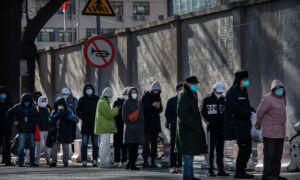
Over the past week, long lines have formed outside fever clinics, calls have inundated China’s emergency hotline, and businesses are preparing for new interruptions as a growing number of employees become sick.
These chaotic scenes unleashed by the Chinese regime’s abrupt reversal of its nearly three-year zero-COVID policy came as the virus raced through the population of 1.4 billion people, raising concerns that authorities were ill-prepared for the hasty reopening.
As of midnight on Dec. 12, Chinese authorities dropped the state-mandated app on mobile phones used to track people’s travel histories. The national app was for authorities to identify whether residents have visited COVID-risky areas during the past 14 days, although critics are concerned that it could be used for mass surveillance and clamping down on dissidents.
The deactivation of the system, also known as “itinerary code,” followed the 10 new guidelines announced by the National Health Commission on Dec. 7, which limited mandatory testing, allowed home quarantines, and scaled back lockdowns.

People cheered the sweeping rollbacks of the regime’s stringent zero-COVID policy on social media. Residents view the recent moves as a signal of returning to normal life after sporadic lockdowns during the past three years upended daily life for hundreds of millions of people. Harsh lockdowns had led to mass hardships from the deprivation of food and health care and deaths in substandard quarantine facilities.
The regime’s retreat from the draconian policy was sparked by the boldest street protests the country has seen in decades.
On the last weekend of November, anti-lockdown demonstrations swept across the country. From Beijing to the remote county of Korla, demonstrators could be seen chanting slogans, pushing back against the regime’s stringent COVID-19 curbs, and demanding freedom. People in Shanghai and elsewhere went further, calling for the Chinese Communist Party (CCP) and its top leader to step down.
Chinese authorities, predictably, didn’t link the policy changes to the nationwide outpouring of anger that was triggered by a deadly blaze last week in Urumqi, the capital city of the far-western Xinjiang province, where parts of the region had been under lockdown for more than three months. Online posts on the country’s social media and Chinese residents blamed the strict COVID-19 curbs for at least 10 deaths, saying the restrictions hampered escape from a burning high-rise apartment building and delayed rescue efforts, an accusation local officials denied.
While the rare official U-turn from the Chinese regime was welcomed among a lockdown-weary populace, observers have sounded the alarm that the country isn’t equipped to handle the effects of this sudden policy shift.
The Chinese hospital system isn’t prepared for a potential surge in infections following the sudden reversal of the zero-COVID policy, according to medical experts. During the COVID-19 pandemic, authorities focused on eliminating infections through snap lockdowns and contact tracing and deployed resources to build quarantine facilities and testing booths instead of expanding wards and intensive care beds.
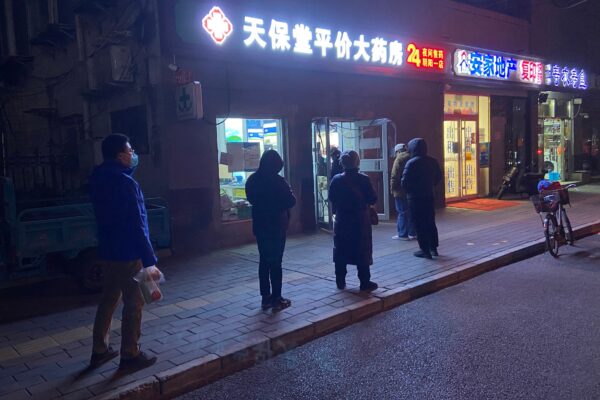
As residents begin flocking to hospitals, state media and health experts are now trying to convince the public that people with mild COVID-19 cases can recover at home—after three years of official messaging that the virus is dangerous and deadly.
Little Preparation
On the first weekend after the relaxation of COVID-19 controls, streets remained largely quiet in Beijing, and some businesses remained closed. In contrast, long lines could be seen outside pharmacies.
Outside fever clinics affiliated with hospitals, dozens of people stood in line for hours in the cold wind to see doctors or get cold or fever medicine that had been out of stock in several pharmacies, according to state media and residents.
“There were so many people [waiting outside the hospital] that I couldn’t see the end at a glance,” said a man who waited for four hours outside Civil Aviation General Hospital in Beijing’s Chaoyang district on Dec. 8.
The patient, who spoke by phone to The Epoch Times on the condition of anonymity for fear of reprisal, said he finally gave up and self-medicated at home for a high temperature and body aches.
A doctor at another hospital in Beijing, the Chaoyang Hospital, said the facility is already “seriously understaffed” because of many nurses and doctors catching COVID-19. Other hospitals in the city are facing the same situation, the doctor, who only gave his surname, Song, told The Epoch Times.
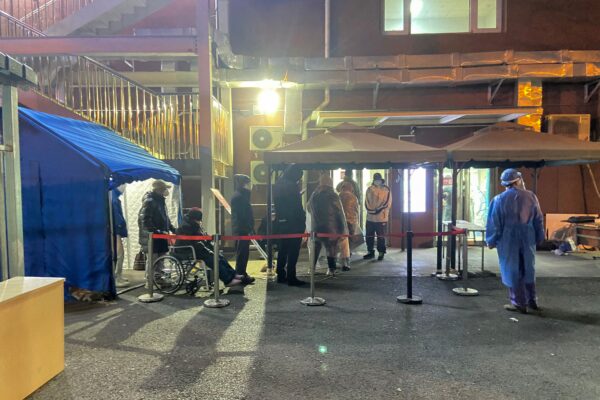
The Emergency Centre in Beijing, an official agency that deals with ambulance calls, is urging people with mild or no COVID-19 symptoms to not call for an ambulance, to save medical resources for those who truly need it.
Calls to the emergency service soared to more than 30,000 per day from the usual average of about 5,000, according to Chen Zhi, chief physician at Beijing’s Emergency Centre.
“With the large increase in the number of calls, the current resources for answering emergency calls and dispatching ambulances are very tight, causing some critically ill patients to encounter difficulties when calling 120 for emergency help,” Chen was quoted as saying in a Dec. 11 report by Beijing Daily, a state-backed media.
Officially, China’s COVID-19 case numbers are falling since the easing of mandatory mass screenings. The National Health Commission recorded 7,679 new infections on Dec. 13, far lower than the more than 10,000 infections reported last weekend.
However, the actual number of infections might be multiple times higher than official tallies, according to residents and experts, given that more people are now buying antigen testing kits to test at home and also the regime’s history of downplaying information about outbreaks.
Zhong Nanshan, a prominent Chinese epidemiologist, told state media that the virus prevalent in China is the highly contagious Omicron coronavirus variant, which one infected person could spread to as many as 18 others.
“In this case, no matter how strong the prevention and control measures are, it will be difficult to completely cut off its transmission chain,” Zhong told Xinhua, China’s official news agency.
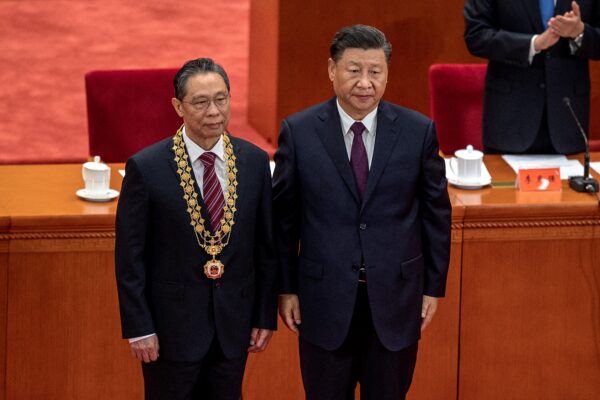
Messaging Change
Domestic media is now downplaying the risk of the Omicron variant and painting it as a flu-like virus. In the same interview published on Dec. 10, Zhong, who had previously reiterated the importance of upholding COVID-19 restrictions, said 99 percent of people now infected with the virus would recover in seven to 10 days.
The remarks marked a U-turn in official messaging.
In October, Dr. Zhang Wenhong, director of the National Center for Infectious Diseases, was quoted by Shanghai authorities as saying that Omicron wasn’t merely a “big flu” and that there was no scientific basis to view the variant could only result in severe influenza.
“Without sufficient medical resources, Omicron will bite,” Zhang said at the time.
Echoing the official narrative, Chinese celebrities, such as e-commerce giant JD.com founder Richard Liu, started to share on social media platforms how they recovered from COVID-19. Such comments have been rare on China’s tightly-controlled internet over the past three years.
“From my own experience, it [COVID-19 symptoms] is indeed milder than a cold,” Liu said in a video on Weibo, a Twitter-like platform.
Liu urged the public to not panic and suggested that those who show mild symptoms seek medical advice online, saving hospital resources for patients who are more ill.
‘Most Severe Test’
The timing of the regime’s rollback of the zero-COVID policy isn’t ideal, according to Sean Lin Xiaoxu, who served in the U.S. Army as a microbiologist.
Winter is the peak season for respiratory diseases, and hospitals will already be facing a surge in patients. At least 3 million people are hospitalized for influenza in China every year, according to Lin.
“The spread of Omicron further complicates the whole situation, which could lead to a squeeze on the health care system,” Lin, who’s based in the United States, told The Epoch Times.
He noted that China’s harsh zero-COVID curbs weren’t able to stop the Omicron variant from spreading but delayed treatment and care for routine illnesses. As the regime inches toward reopening, Lin expects that non-COVID patients will flock back to hospitals, further straining the medical system.
To legitimize its harsh policy, the regime’s official media painted the Omicron variant as dangerous. Lin said the propaganda caused fear of COVID-19 among the public, adding risks that hospitals will be overwhelmed going forward.
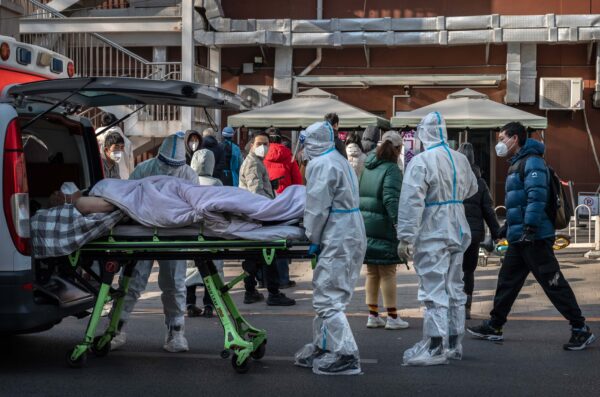
Gordon Chang, author and a senior fellow of Gatestone Institute, said authorities’ commitment to the zero-COVID policy had affected the ability to expand intensive care bed capacity and other medical resources.
“The emphasis on isolation deprived the Chinese central government of the resources to build, among other things, ICUs and general hospital beds. The government did build—and appears to be still building—massive quarantine facilities, like a 250,000-bed location in Guangzhou,” he said in a Dec. 10 commentary on the website 19fortyfive.
The regime was reluctant to prepare a plan B should its isolation approach fail, Chang wrote, although the zero-COVID policy itself was “obviously unsustainable.”
The China expert viewed the unprecedented outbreaks the country now faces as one of the communist regime’s “most severe tests ever.” But the CCP “has no one to blame for its regime-threatening predicament.”
“From the beginning of the pandemic, it made its control of disease a test of its legitimacy, boasting that its ability to deal with the coronavirus was proof of the superiority of Chinese communism over democracy in general and American democracy in particular,” he said.
Hong Ning, Luo Ya, and Reuters contributed to this report.













